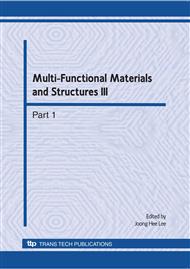p.587
p.591
p.595
p.599
p.603
p.607
p.611
p.615
p.619
Viscoelastic Characterization of Fiber-Reinforced Elastomeric Composites at Finite Strain
Abstract:
A viscoelastic model is developed to describe the mechanical response of fiber-reinforced elastomeric composites at large deformation. A continuum approach is used to model the macroscopic mechanical behavior of elastomeric materials reinforced with unidirectional fibers, in which the resin and fibers are regarded as a single homogenized anisotropic material. The anisotropic viscoelastic constitutive model is developed considering transient reversible network theory. An efficient computational algorithm based on micromechanical modeling is proposed to relate the material parameters of constitutive model to the mechanical properties of composite constituents at finite strain. The microstructure is identified by a representative volume element (RVE) and it is subjected to large deformation with considering the conformity of opposite boundaries. The material parameters of the viscoelastic constitutive law are determined based on the response of heterogeneous microstructure which is examined under different loading conditions.
Info:
Periodical:
Pages:
603-606
Citation:
Online since:
August 2010
Authors:
Keywords:
Price:
Сopyright:
© 2010 Trans Tech Publications Ltd. All Rights Reserved
Share:
Citation:


